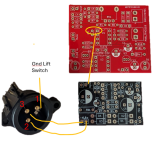I am using for guitar, but since it is an interface, it has mic inputs, so pretty versatile. Mainly I plan on using it with my modeling pedal.The Kinter is just a power amp, there is a bypass for the EQ. Sort of a rigged up FRFR cabinet. I don't want to blow the Weber it's a pretty nice speaker, not cheap.are you using this for instruments? or for home stereo? you could always try the Weber with that setup and replace it if/when you find out it is not able to do what you want or it self-destructs.
TPA3118 60W Power Amp Module
- Thread starter falzhobel
- Start date

